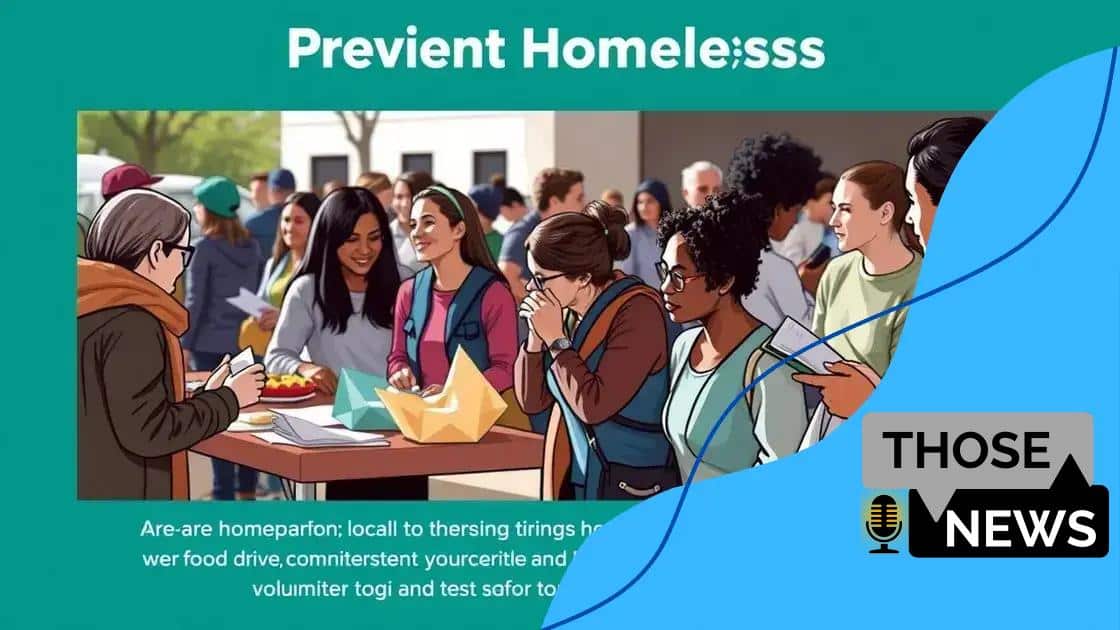Homelessness prevention strategies that really work

Homelessness prevention strategies encompass understanding root causes, implementing effective programs, and fostering community involvement, all supported by government policies and innovative solutions to assist at-risk populations.
Homelessness prevention strategies play a crucial role in creating lasting support systems for individuals at risk. Have you ever considered how these strategies can transform lives? Here, we delve into effective methods that not only help keep people housed but also build stronger communities.
Understanding the root causes of homelessness
Understanding the root causes of homelessness is essential for creating effective solutions. Many factors contribute to this complex issue, and addressing them can help prevent homelessness before it starts.
Socioeconomic Factors
One major cause is poverty. When people do not have enough income to cover their basic needs, the risk of homelessness increases. Additionally, job loss, lack of affordable housing, and rising living costs all play significant roles.
Health Issues
Health complications, both physical and mental, can lead to homelessness. Individuals suffering from mental health disorders may find it difficult to maintain stable housing without support. Furthermore, chronic illnesses can deplete financial resources, making housing unattainable.
Family Dynamics
Family instability is another major contributor. Domestic violence often forces individuals to leave their homes, leaving them homeless. Children in these situations may experience trauma that affects their future stability.
Systemic Issues
- Inadequate social services
- Discrimination in housing
- Insufficient mental health support
- Limited access to education
These systemic issues create barriers that prevent vulnerable populations from achieving stability. By understanding these root causes, communities can better tailor their interventions.
In conclusion, recognizing the various factors that lead to homelessness is critical. Armed with this knowledge, we can develop targeted homelessness prevention strategies that address these underlying issues.
Effective programs for preventing homelessness
Effective programs for preventing homelessness focus on addressing both immediate needs and long-term solutions. These initiatives provide support and resources to individuals and families, aiming to keep them stable in their housing situations.
Housing First Approach
One successful method is the Housing First approach. This strategy prioritizes providing permanent housing to those in need without preconditions. Once housed, individuals can access additional supportive services such as job training and mental health support.
Financial Assistance Programs
Financial assistance programs are vital. They can help families pay rent or utility bills during tough times. By offering short-term cash assistance, these programs prevent eviction and allow families to remain in their homes.
Support Services
- Case management
- Counseling services
- Job training and employment programs
- Substance abuse treatment
Support services play a crucial role in ensuring individuals can maintain stable housing. By addressing underlying issues, these services pave the way for lasting stability.
Collaboration between community organizations and local governments can amplify the effectiveness of these programs. With coordinated efforts, resources can be maximized to reach more individuals in need. Addressing homelessness requires a multifaceted approach, and utilizing effective programs is vital for success.
Community involvement in prevention strategies

Community involvement in prevention strategies is essential for successfully tackling homelessness. When communities come together, they can create meaningful solutions that address the needs of vulnerable individuals and families.
Building Awareness
One critical step is building awareness about homelessness. By educating community members about the causes and realities, more people can become engaged in prevention efforts. Awareness campaigns can highlight local resources and services available to those at risk.
Volunteering and Support
Volunteering is another way for community members to contribute. Local organizations often need volunteers to assist with outreach, provide meals, or mentor individuals. A few impactful ways communities can get involved include:
- Participating in food drives
- Organizing fundraising events
- Helping with job placement programs
- Offering workshops on financial literacy
These actions create a sense of solidarity and provide crucial resources to those at risk of homelessness. Engaging local businesses can further amplify efforts, as they can offer job opportunities to those in need.
Creating relationships with local government can also enhance these strategies. Collaboration ensures that resources are allocated effectively and that programs meet the community’s unique needs. When everyone plays a part, the collective effort can lead to innovative solutions and lasting change.
Role of government and policy in addressing homelessness
The role of government and policy in addressing homelessness is critical for effective prevention strategies. By creating and implementing supportive policies, governments can significantly impact the lives of individuals and families at risk of homelessness.
Legislation and Funding
Government legislation sets the foundation for programs aimed at preventing homelessness. Funding these initiatives is essential to ensure they can operate effectively. Affordable housing policies can provide financial assistance, while housing vouchers can help families secure housing they can afford.
Support Services
In addition, local governments are responsible for providing essential support services. These may include:
- Access to mental health resources
- Substance abuse treatment programs
- Job training and employment services
- Emergency shelter resources
These programs empower individuals with skills and resources to regain stability in their lives. When support services are readily available, individuals are less likely to fall into homelessness.
Collaboration with Nonprofits
Another key aspect is the collaboration between government agencies and nonprofit organizations. Working together allows for a better allocation of resources and more comprehensive solutions. For example, by partnering with local nonprofits, governments can enhance outreach efforts, ensuring that those in need are aware of available services.
Additionally, data collection and analysis by governments can inform policies. Understanding the specific needs of homeless populations helps tailor programs that prevent homelessness more effectively. Evidence-based policies ensure that funding is directed toward methods that work.
Innovative solutions to support at-risk populations
Innovative solutions to support at-risk populations are crucial for preventing homelessness and fostering stability. These solutions often leverage technology, community engagement, and creative approaches to address the unique challenges faced by vulnerable groups.
Technology in Support Services
One significant innovation is the use of technology to connect those in need with resources. For instance, mobile apps can help individuals find shelter, job opportunities, and social services all in one place. These resources can be accessed easily, ensuring that those at risk receive the support they need promptly.
Community-Based Initiatives
Community-based programs play a vital role as well. Local organizations are often best equipped to understand the specific needs of their communities. Examples of effective initiatives include:
- Peer support groups that offer emotional and practical assistance
- Job training programs tailored to the local job market
- Mobile health clinics providing free medical services
- Neighborhood watch programs that enhance community safety
These initiatives not only provide immediate help but also foster a sense of belonging and support among participants. When individuals see their community investing in their well-being, it strengthens resilience.
Collaboration and Partnerships
Collaboration between various sectors also paves the way for innovative solutions. When governments, businesses, and non-profits work together, they can create comprehensive support systems. For example, a local business might partner with a nonprofit to offer internships for community members. This type of program provides essential work experience while tackling unemployment.
By combining resources and ideas, communities can develop unique approaches that effectively address the challenges faced by at-risk populations. These innovative solutions build a more stable and supportive environment where everyone has the opportunity to thrive.
In conclusion, addressing homelessness requires a multifaceted approach that involves understanding root causes, implementing effective prevention strategies, and fostering community involvement. By leveraging innovative solutions and ensuring government support, we can create a more stable environment for at-risk populations. Collaboration between various stakeholders is key to developing successful programs that empower individuals and families to regain their footing. Together, we can build a society where everyone has access to safe and stable housing, ultimately preventing homelessness.
FAQ – Frequently Asked Questions about Homelessness Prevention Strategies
What are the main causes of homelessness?
Homelessness can stem from various factors, including poverty, lack of affordable housing, health issues, and family instability.
How can community involvement help prevent homelessness?
Community involvement raises awareness, provides resources, and fosters support networks, which are vital for assisting at-risk populations.
What role does government policy play in homelessness prevention?
Government policy is crucial as it creates and funds programs that support affordable housing, provide services, and target the root causes of homelessness.
What innovative solutions are being used to support at-risk populations?
Innovative solutions include using technology for resource access, community-based programs for training and support, and partnerships across sectors to maximize impact.





